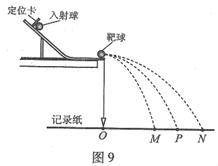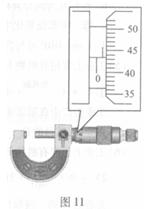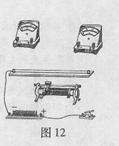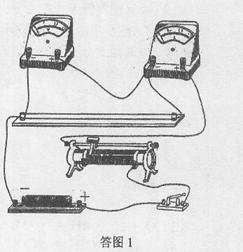(18分)
(1)如图9所示为“验证碰撞中的动量守恒”的实验装置。

①下列说法中不符合本实验要求的是 。(选填选项前面的字母)
A.入射球比靶球质量大或者小均可,但二者 的赢径必须相同
的赢径必须相同
B.在同一组实验的不同碰撞中,每次入射球必须从同一高度由静止释放
C.安装轨道时末端必须水平
D.需要的测量仪器有天平和刻度尺
②实验中记录了轨道末端在记录纸上的竖直投影为O点,经多次释放入射球,在记录纸上找到了两球的平均落点位置M、P、N,并测得它们到O点的距离分别为 、
、 和
和 。已知入射球的质量为
。已知入射球的质量为 ,靶球的量为
,靶球的量为 ,如果测得
,如果测得 近似等于 ,则可认为成功验证了碰撞中的动量守恒。
近似等于 ,则可认为成功验证了碰撞中的动量守恒。
(2)用一段长为80cm的金属丝做“测定金属的电阻率”的实验。
①用多用表粗测电阻丝的电阻,结果如图10所示,由此可知电阻丝电阻的测量值约为
 。
。

②用螺旋测微器测量金属丝的直径,结果如图11所示,由此可知金属丝直径的测量结果为
mm。

③在用电压表和电流表测金属丝的电阻时,提供下列供选择的器材:
A.直流电源(电动势约为4.5V,内阻很小)
B.电压表(量程0~3V,内阻约3k )
)
C.电压表(量程0~15V,内阻约15k )
)
D.电流表(量程0~0.6A,内阻约0.125 )
)
E.电流表(量程0~3A,内阻约0.025 )
)
F.滑动变阻器(阻值范围0~15 ,最大允许电流1A)
,最大允许电流1A)
G.滑动变阻器(阻值范围0~200 ,最大允许电流2A)
,最大允许电流2A)
H.开关、导线。
要求有较高的测量精度,并能测得多组数据,在供选择的器材中,电流表应选择 ,电压表应选择 ,滑动变阻器应选择 。(填字母代号)
,电压表应选择 ,滑动变阻器应选择 。(填字母代号)
④根据上面选择器材,完成图12中实验电路的连接。
(1)①A (3分);② (3分)
(3分)
(2)①6(2分)(说明:6.0也得分)
②0.933~0.936(2分)
③D B F(每空2分,共6分);④见答图1(连成分压电路正确的同样得分)(2分)

